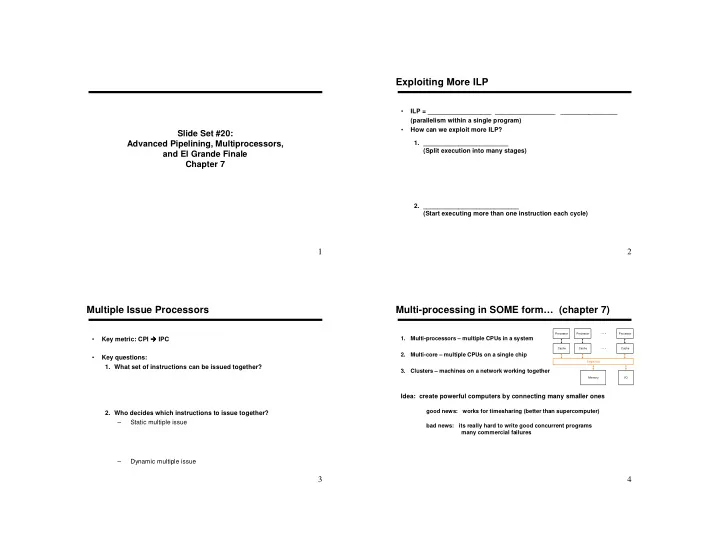

Exploiting More ILP • ILP = __________________ _________________ ________________ (parallelism within a single program) • How can we exploit more ILP? Slide Set #20: Advanced Pipelining, Multiprocessors, 1. ________________________ (Split execution into many stages) and El Grande Finale Chapter 7 2. ___________________________ (Start executing more than one instruction each cycle) 1 2 Multiple Issue Processors Multi-processing in SOME form… (chapter 7) Processor Processor Processor Key metric: CPI � � � � IPC 1. Multi-processors – multiple CPUs in a system • Cache Cache Cache 2. Multi-core – multiple CPUs on a single chip • Key questions: Single bus 1. What set of instructions can be issued together? 3. Clusters – machines on a network working together Memory I/O Idea: create powerful computers by connecting many smaller ones good news: works for timesharing (better than supercomputer) 2. Who decides which instructions to issue together? – Static multiple issue bad news: its really hard to write good concurrent programs many commercial failures – Dynamic multiple issue 3 4
Who? When? Why? Multiprocessor/core: How do processors SHARE data? 1. Shared variables in memory • “For over a decade prophets have voiced the contention that the organization of a single computer has reached its limits and that truly significant advances can be made only by interconnection of a Processor Processor Processor P rocessor Processor P rocessor multiplicity of computers in such a manner as to permit cooperative Cache Cache Ca che Cache Cache Cache solution…. Demonstration is made of the continued validity of the OR single processor approach…” S ingle bus Memory Memory Memory Mem ory I/O Network “Symettric Multiprocessor” “Non-Uniform Memory “Uniform Memory Access” Access” Multiprocessor 2. Send explicit messages between processors • “…it appears that the long-term direction will be to use increased silicon to build multiple processors on a single chip.” Processor Processor Processor Cache Cache Cache Memory Memory Memory Network 5 6 Multiprocessor/core: How do processors COORDINATE? Flynn’s Taxonomy of multiprocessors(1966) • synchronization 1. Single instruction stream, single data stream • built-in send / receive primitives 2. Single instruction stream, multiple data streams • operating system protocols 3. Multiple instruction streams, single data stream 4. Multiple instruction streams, multiple data streams 7 8
Example Multi-Core Systems (part 1) Example Multi-Core Systems (part 2) 2 × quad-core 2 × oct-core Intel Xeon e5345 Sun UltraSPARC (Clovertown) T2 5140 (Niagara 2) 2 × quad-core 2 × oct-core AMD Opteron X4 2356 IBM Cell QS20 (Barcelona) 9 10 Clusters • Constructed from whole computers • Independent, scalable networks • Strengths: – Many applications amenable to loosely coupled machines A Whirlwind tour of – Exploit local area networks Chip Multiprocessors and Multithreading – Cost effective / Easy to expand • Weaknesses: – Administration costs not necessarily lower – Connected using I/O bus Slides from Joel Emer’s talk at • Highly available due to separation of memories Microprocessor Forum • Approach taken by Google etc. 11 12
Instruction Issue Superscalar Issue Time Time ������������������������������������������ ������������������������������������������������������������ 13 14 Chip Multiprocessor Fine Grained Multithreading Time Time ������������������������������������������������ ������������������������������������������������� 15 16
Concluding Remarks Simultaneous Multithreading • Goal: higher performance by using multiple processors / Time cores • Difficulties – Developing parallel software – Devising appropriate architectures • Many reasons for optimism – Changing software and application environment – Chip-level multiprocessors with lower latency, higher bandwidth interconnect • An ongoing challenge! �� ������������������������������������������������������������ 17 18
Recommend
More recommend